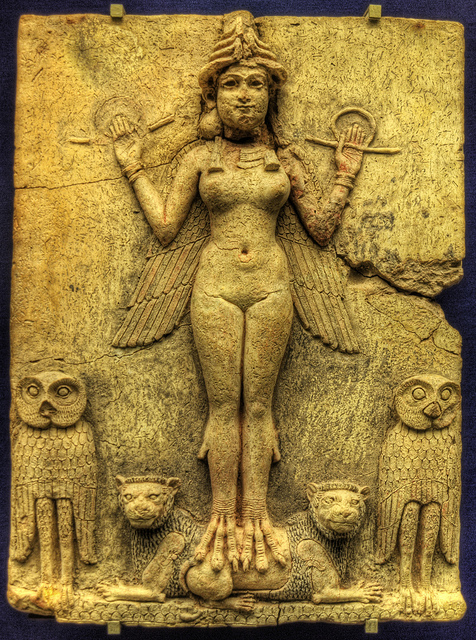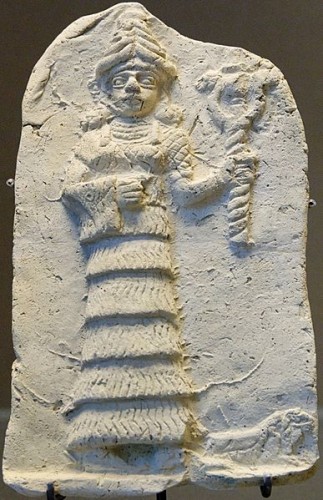A couple of weeks ago, Michelle subverted the established cultural order by adopting her five-year old’s suggestion that Bilbo Baggins was a girl. Most people applauded but some gnashed their teeth: don’t second-guess literature, they said, and if Bilbo is a hero and heroes are boys, then so be it. But I have prior and inside knowledge of this very issue and will hereby share it.
 Ashtoreth, Astarte, Ishtar, Inanna – a good first line for a poem. They’re different names for the same ancient Near Eastern goddess. Inanna is Sumerian and the oldest, five or six thousand years old, as old as writing itself when it was made by reeds in soft clay, and maybe older. Inanna was the first of the great Campbellian heroes with a thousand faces – from Theseus and Orpheus, to Dante, to the hobbits Baggins and Luke Skywalker – who had a quest and went to the underworld, helped by divine and inhuman companions, and who returned. In short, Michelle’s five-year old was right: the first Bilbo Baggins was a girl.
Ashtoreth, Astarte, Ishtar, Inanna – a good first line for a poem. They’re different names for the same ancient Near Eastern goddess. Inanna is Sumerian and the oldest, five or six thousand years old, as old as writing itself when it was made by reeds in soft clay, and maybe older. Inanna was the first of the great Campbellian heroes with a thousand faces – from Theseus and Orpheus, to Dante, to the hobbits Baggins and Luke Skywalker – who had a quest and went to the underworld, helped by divine and inhuman companions, and who returned. In short, Michelle’s five-year old was right: the first Bilbo Baggins was a girl.
But Inanna in no other way fits the hero archetype — nor any other particular archetype, though scholars have tied themselves in knots trying. She was goddess of nothing in particular and was pissed off about that. So she got her father, Enki the head god, drunk enough to give her the “me’s,” possessions generally, including the culture and offices of the world: righteousness, the plundering of cities, the making of lamentations, deceit, kindness, all the useful crafts, plus wisdom, respect, awe, and reverent silence. When Enki sobered up and tried mightily to get it all back, she refused and won – among the me’s was triumph. She liked war: clad in terror, riding on the great divine powers, drenched in blood, rushing around in great battles, great lady Inanna. She liked sex and had a lot of lovers but tended to do them in – to the extent that when she proposed marriage to the hero Gilgamesh, he refused her, saying he didn’t want to end up maimed, changed, or dismembered. She was raped once, and afterward when the rapist hid in the mountains, she sent storms and filled the wells with blood; and when she did find him, she killed him. She wasn’t just a hero, not just a goddess of love, not just a goddess of war. She broke the molds long before the molds were even created.
 One day while in the great heaven, she set her mind on the great below, on the underworld. So she put on the garment of ladyship, added a wig and a turban, hung small lapis-lazuli beads around her neck, put two large egg-shaped beads and a pectoral on her breast, put on mascara, then a golden ring, took her me’s in one hand and the lapis-lazuli measuring rod and measuring line in the other, and with her companion, Nincubura, she set out. When she reached the underworld, she banged on the gates and shouted, “Open up, doorman! Open up! I am all alone and I want to come in.” The doorman ran to the head of the underworld, Ereshkigal, who happened to be Inanna’s sister. Ereshkigal was distressed, slapped the side of her thigh, bit her lip, thought for a while, and told the doorman to let Inanna in. Inanna entered through each of the underworld’s seven gates, but at each gate, something was taken from her, first her lapis lazuli measuring rod and line, then her beads and pectoral, then her lapis lazuli necklace, her garment of ladyship, one by one, until she was naked. And naked she walked to her sister’s throne and sat on it.
One day while in the great heaven, she set her mind on the great below, on the underworld. So she put on the garment of ladyship, added a wig and a turban, hung small lapis-lazuli beads around her neck, put two large egg-shaped beads and a pectoral on her breast, put on mascara, then a golden ring, took her me’s in one hand and the lapis-lazuli measuring rod and measuring line in the other, and with her companion, Nincubura, she set out. When she reached the underworld, she banged on the gates and shouted, “Open up, doorman! Open up! I am all alone and I want to come in.” The doorman ran to the head of the underworld, Ereshkigal, who happened to be Inanna’s sister. Ereshkigal was distressed, slapped the side of her thigh, bit her lip, thought for a while, and told the doorman to let Inanna in. Inanna entered through each of the underworld’s seven gates, but at each gate, something was taken from her, first her lapis lazuli measuring rod and line, then her beads and pectoral, then her lapis lazuli necklace, her garment of ladyship, one by one, until she was naked. And naked she walked to her sister’s throne and sat on it.
Then the seven judges, the Annunaki, spoke to her with the speech of anger and looked at her with the look of death. And Inanna was turned into a corpse. And the corpse of Inanna was hung on a hook.
Back in the great heaven, after three days and night, Inanna’s companion Nincubura, went to each of the great gods and pleaded with them, “Don’t let your daughter be killed in the underworld. Don’t let your precious metal be alloyed there with the dirt of the underworld.” And each one of them said back, “Inanna craved the great heaven and she craved the great below as well. The divine powers of the underworld are divine powers which should not be craved, for whoever gets them must remain in the underworld.” But her father, Enki, was sorry, and he took some dirt from under his fingernails and made two inhuman beings who could flit past the underworld’s doors like flies, like phantoms. And these beings went to Ereshkigal, the queen of the underworld, and sympathized with her because she was so unhappy; and when in gratitude for the sympathy she offered them rivers of water and fields of grain, they refused. They said “No. Give us the corpse hanging on the hook.” And the beings returned Inanna to life.
But as Inanna went to leave the underworld, the seven Annunaki stopped her and said that before she could leave, she had to provide a substitute. So Inanna left the underworld, accompanied by demons to make sure she found a substitute, and went from city to city. Every person they found, Inanna said how that person had been devastated by her death, how precious that person was to her, how could she turn that person over to the demons? “Let’s keep looking,” she said, “let’s go on.” Finally they came to the plain of Kulaba and found Inanna’s husband, Dumuzi, under a great apple tree, seated magnificently on a throne and wearing a magnificent garment, and not devastated at all. Inanna looked at him with the look of death and spoke to him with the speech of anger. Then she gave Dumuzi into the hands of the demons who bound his arms, covered his head with his own garment, and took him away to the underworld.
Then she remembered her days with Dumuzi, how she anointed herself with sweet oil and straightened the lapis lazuli stones on her neck, and met Dumuzi at the door and like a moonbeam came forth to him from the house; and how he rejoiced in her and kissed her. And then holy Inana wept bitterly for her husband and ripped out her hair like esparto grass, and cried,” You wives who lie in your men’s embrace, where is my precious husband? Where is my man?”
§
Well she might ask; didn’t she hand him over to the underworld herself? The story of Dumuzi continues – he’s a Persephone archetype – but Inanna isn’t in it any more. She goes about her life, challenging mountains and the Bull of Heaven, murdering her own challengers, having hymns of praise and bribery written to her. She’s a hero, a Great Mother, an Aphrodite, a Mars, all of them and none of them completely, and acquisitive to boot. She sounds like she was born before the archetypes pulled themselves together.
I first heard about her in 1979. I can’t say I like her and I wouldn’t recommend her as a role model for anybody’s daughter, but I sure don’t forget her. And I don’t want to hear any more arguments about heroes necessarily being boys either.
__________
Much of the language here and most of the stories are from Black, J.A., Cunningham, G., Fluckiger-Hawker, E, Robson, E., and Zólyomi, G., The Electronic Text Corpus of Sumerian Literature (http://www-etcsl.orient.ox.ac.uk/), Oxford 1998- . The story of her proposal to Gilgamesh and his refusal is actually a story about Ishtar, Inanna’s later Akkadian avatar. The names have no one spelling and you’ll do well to remember they’re transliterations of arrangements of little wedges on broken tablets.
The top photo is from Neil Howard, via Flicker; she’s putatively Inanna, more probably Ishtar, or maybe somebody else altogether and is in the British Museum. The second photo is from Wikimedia Commons, is in the Louvre, and is also Ishtar. Inanna doesn’t seem to lend herself to publicly-available or reliably-attested images.
I’ve worked with this myth quite a bit and have a different take on several aspects, eg Inanna was the goddess of heaven and earth before the drinking party with Enki and what she stole from him was the necessary tools to create order.
But one great thing about myth is its flexibility.
Anyway, I’m glad find another advocate for female heroes and fan of Sumerian mythology. Thanks.
The first illustration is the Burney Plaque & my understanding is that it is an illustration of Lileth. Created equal with Adam by God, she refused to be subservient to Adam & so he threw her out of Eden, and that’s where the stories really start to get interesting…..
Yeah, as I said, “maybe somebody else altogether.” But Lilith, I don’t trust as far as I can throw her, she’s so political. But thank you for bringing her up.